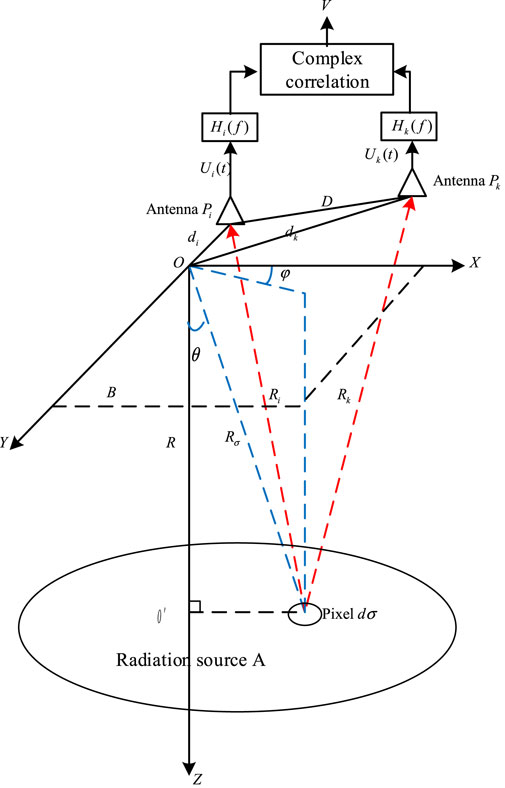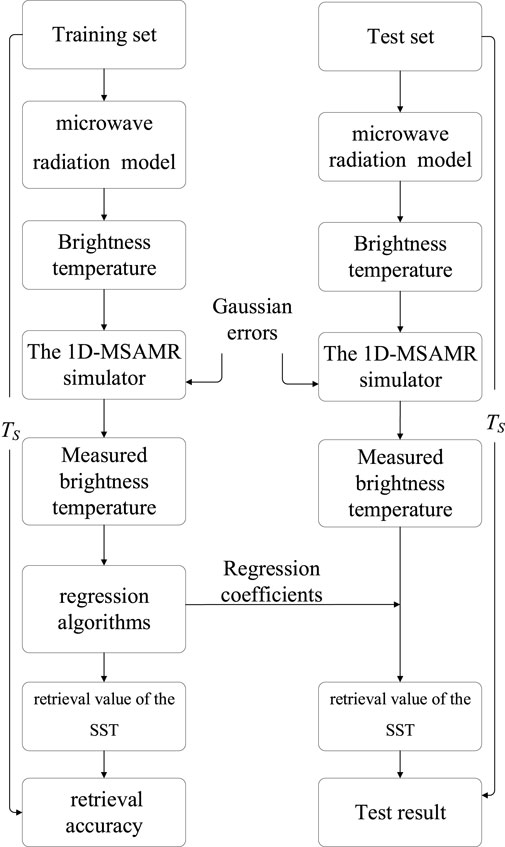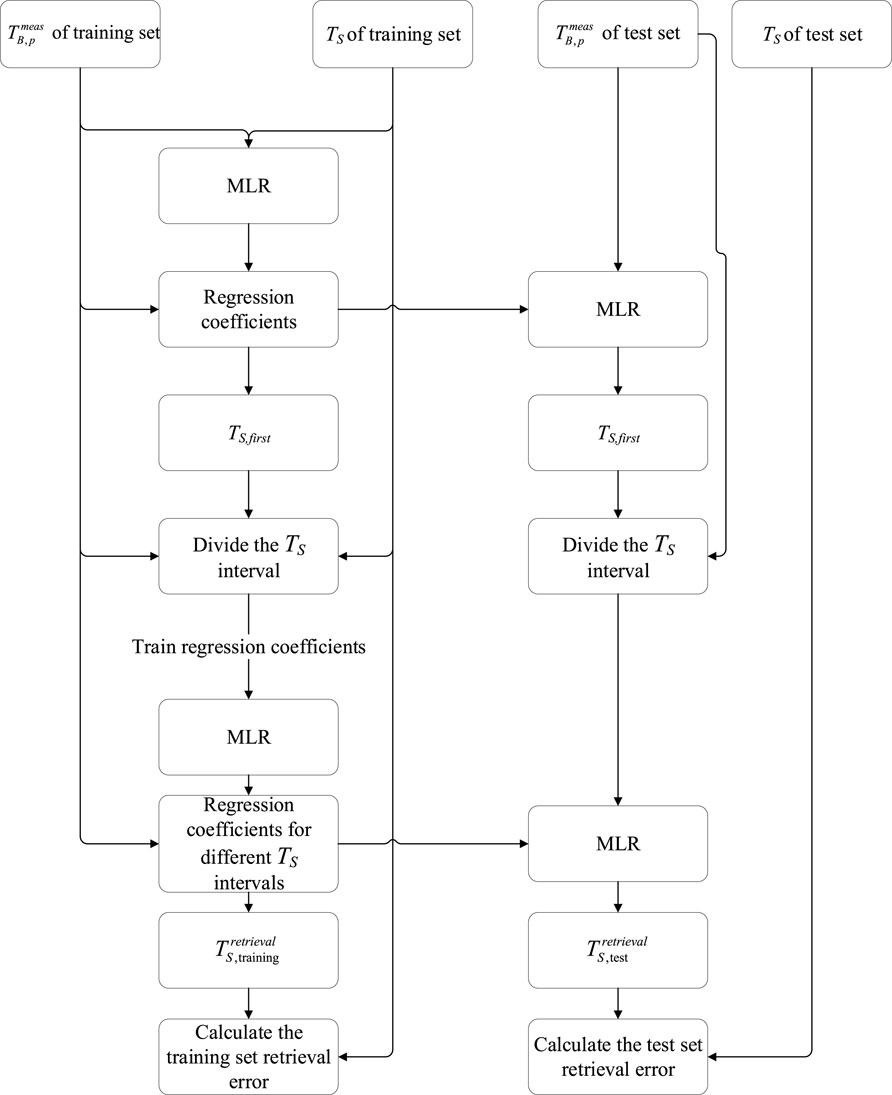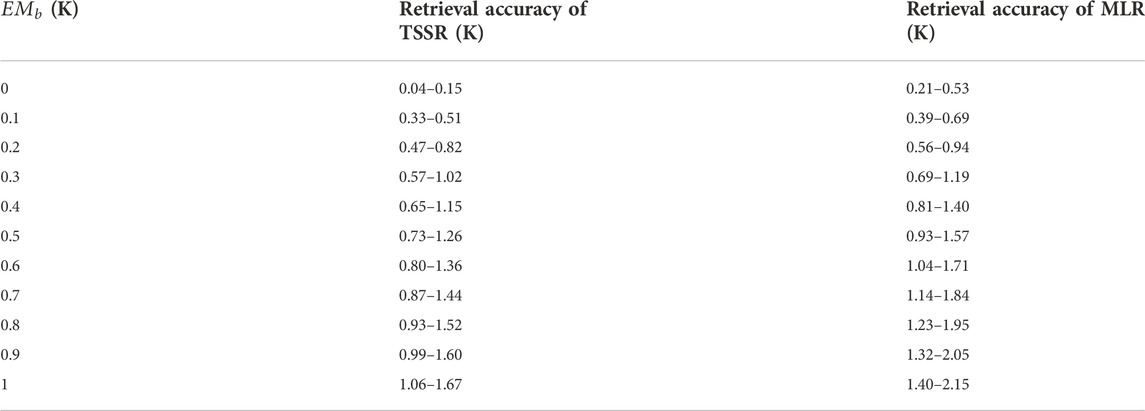- College of Meteorology and Oceanography, National University of Defense Technology, Changsha, China
The space-borne one-dimensional multifrequency synthetic aperture microwave radiometer (1D-MSAMR) offers new possibilities for detecting high spatial resolution sea surface temperature (SST). To achieve higher SST retrieval accuracy, an SST retrieval algorithm, the two-step retrieval algorithm (TSSR), is proposed based on the multiple linear regression (MLR) algorithm. In this study, we investigated the SST retrieval accuracy of 1D-MSAMR based on simulation experiments. For the study, we assumed that the frequencies of the 1D-MSAMR were 6.9, 10.65, 18.7, 23.8, and 36.5 GHz, and that all frequencies worked in a dual polarization (vertical and horizontal) manner. We used an ocean-atmosphere microwave radiation brightness temperature model and the 1D-MSAMR simulator to simulate the measured brightness temperature based on WindSat data provided by the Remote Sensing Systems (RSS). An MLR algorithm and the TSSR were then developed to retrieve the SST within the incidence angle range of 0°–65°. The results show that the SST retrieval errors of the two SST retrieval algorithms decreased with the increase of incidence angle. The TSSR had higher retrieval accuracy, especially at low incidence angle. The average retrieval accuracy of the TSSR was about 0.3 K higher than that of the MLR algorithm. The retrieval error of the TSSR was also less sensitive to the measurement error of the 6.9 GHz frequency than the MLR algorithm.
1 Introduction
With the development of satellite remote sensing technologies, remote sensing data is now being used to monitor global sea surface temperature (SST). Clouds and aerosols are essentially transparent to microwave radiation at frequencies below about 12 GHz, therefore microwave remote sensing can potentially eliminate the atmospheric contamination problems that plague infrared measurements and is considered an enabling technology for all-day and all-weather SST measurement (Chelton and Wentz, 2005). Most microwave radiometers in orbit are real-aperture radiometers with conical scanning, such as the TMI, WindSat, AMSR2, and HY-2. Real-aperture microwave radiometers require large and massive antennas for high spatial resolution, such as that of the CIMR (Ulaby, 1981; Lise et al., 2018).
A synthetic aperture microwave radiometer using an interferometric technique is proposed to overcome the barriers that antenna size has placed on passive microwave sensing from space (RYLE, 1962; Vine, 2000). In such systems, the correlation of the output voltage from pairs of antennas with different spacing (baselines) is measured (Le et al., 1994; Jin et al., 2019). The product at each baseline yields a sample point in the Fourier transform of the brightness temperature map of the scene, and the scene itself is reconstructed by inverting the sampled transform (Le and David, 1990; Vine et al., 1992).
Several synthetic aperture microwave radiometers have been developed for Earth observation, such as electronically steered thinned array L-band radiometer (ESTAR) (Vine et al., 2004), MIRAS (Zine et al., 2008), and GeoSTAR (Lambrigtsen et al., 2006). The first space-borne synthetic aperture microwave radiometer, MIRAS, was mounted onboard the SMOS (Soil Moisture and Ocean Salinity) satellite which is a Y-sparse structure having many small receivers evenly distributed along the arms (Zine et al., 2008). The MIRAS provides soil moisture and ocean surface salinity global coverage measurements from space (Jordi et al., 2010). A study called MICROWAT showed that two-dimensional interferometric systems would be very complex (with a 3.9 K sensitivity on each measurement) and would not satisfy the user requirements in terms of SST accuracy. As a practical alternative, a one-dimensional interferometric system has a much lower systematic complexity, with 0.15 K sensitivity at 6.9 GHz and 0.35 K sensitivity at 18.7 GHz (Prigent et al., 2013).
The first one-dimensional synthetic aperture microwave radiometer (1D-MSAMR), ESTAR, was installed on an aircraft and operates at L-band. This system adopts the real-aperture along the track and the synthetic aperture cross-track dimension, and obtains an angular resolution of 7° (Le et al., 1994). The HUST-ASR is a one-dimensional synthetic aperture microwave radiometer developed by Huazhong University of Science and Technology that generates high-quality images of natural scenes (Li et al., 2008). An SST sensitivity and physical retrieval method based on the C-band 1D-MSAMR has been investigated (Ai et al., 2020; Feng et al., 2022).
At present, the SST retrieval algorithms for microwave remote sensing include primarily physical algorithms (Meissner and Wentz, 2012; Koner and Harris, 2015; Wentz, 2000; Bettenhausen et al., 2006; Brown et al., 2006) and empirical algorithms (Goodberlet et al., 1990; Wentz, 2000; Obligis et al., 2005; Krasnopolsky et al., 2000). The multiple linear regression (MLR) algorithm, one of the empirical algorithms, can be used as an on-board SST retrieval algorithm, as it has minimal computational requirements.
We aimed to develop an on-board SST retrieval algorithm suitable for 1D-MSAMR. In this study, a new SST retrieval algorithm based on MLR, the two-step retrieval algorithm (TSSR), for 1D-MSAMR is proposed. We used the ocean-atmosphere microwave radiation brightness temperature model and the 1D-MSAMR simulator to simulate the brightness temperature detected by 1D-MSAMR. TSSR and MLR were used to retrieve SST. Ample research has demonstrated that the C-band is the most sensitive to SST and is an important frequency band for SST retrieval (Wentz and Meissner, 2007; Ai et al., 2020). In addition, Feng et al. (2022) studied the influence of different frequency combinations on SST retrieval accuracy and showed that the 5-frequency combination scheme resulted in the highest SST retrieval accuracy. Therefore, we assumed that the frequencies of the 1D-MSAMR were 6.9, 10.65, 18.7, 23.8, and 36.5 GHz and that all frequencies worked in a dual polarization (vertical and horizontal) manner. Through the simulation model, we investigated the relationship between the retrieval accuracy and the brightness temperature measurement errors
This article is organized as follows. Section 2 introduces measured brightness temperature simulation and the SST retrieval algorithms. The results and discussion are provided in Section 3, followed by conclusions in Section 4.
2 Brightness temperature simulation and SST retrieval algorithms
2.1 Ocean-atmosphere microwave radiation brightness temperature model
We built an ocean-atmosphere microwave radiation brightness temperature model to simulate the brightness temperature received by the 1D-MSAMR (
where p denotes the polarization mode,
The ocean-atmosphere microwave radiation brightness temperature model is divided into two parts, the atmospheric absorption emission model, and the sea surface emissivity model. The atmospheric absorption emission model used in this study was developed by Wentz (2000) for the AMSR. The sea surface emissivity model used in this study was developed by Meissner and Wentz (2012). The model assumes that the sea surface roughness is only related to the sea surface wind vector, and the specific formula for calculation of sea surface emissivity was not provided.
2.2 The 1D-MSAMR simulator and EMb simulation
The 1D-MSAMR simulator is used to simulate the entire process of 1D-MSAMR detection of bright temperature. The schematic diagram of the detection process is shown in Figure 1. The 1D-MSAMR uses the principle of binary interference imaging wherein
The formula for calculation of the visibility function and image reconstruction of the microwave interferometric radiometer with the 1D-MSAMR simulator is as follows (Wentz and Meissner, 2007; Lise et al., 2018):
where
We used the brightness temperature received by the 1D-MSAMR to calculate the model brightness temperature
2.3 SST retrieval algorithm
Figure 2 shows the schematic diagram of the SST retrieval experiment. First, we established a complete data set describing the background field of the atmosphere and ocean environment. The data were then divided into training and test sets. The second step was to establish an ocean-atmosphere microwave radiation brightness temperature model to calculate the brightness temperature received by the 1D-MSAMR. The simulator with different Gaussian noises was then used to simulate the measured brightness temperature (
The 1D-MSAMR has the characteristics of multiple incidence angles that influence the brightness temperature considerably. Therefore, SST must be retrieved separately from different incidence angles. We used two different SST retrieval algorithms: MLR and TSSR (based on MLR). Calculation of MLR (Wentz and Meissner, 2007) was as follows:
where
For TSSR,
3 Results and discussion
3.1 Data
This study used the data products of WindSat in Remote Sensing Systems (RSS) to establish the background field data. The data were 7-day average data product worldwide from 2016 to 2018. Specifically, the data included SST (
This research focused on the retrieval of SST in the case of non-precipitation; therefore, we excluded data with
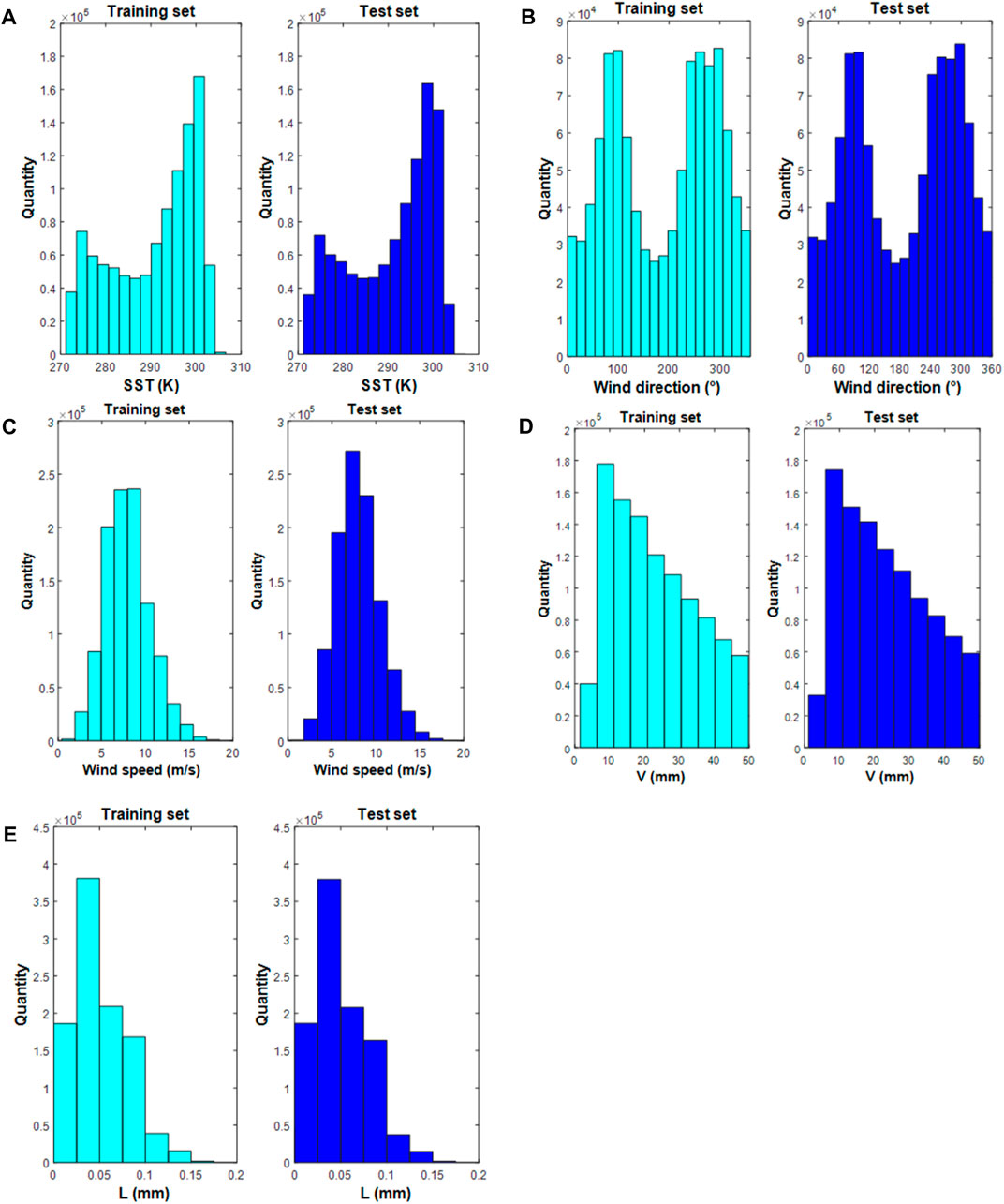
FIGURE 4. Histograms of the atmospheric-ocean background field data. The training set is shown on the left and the test set on the right. (A) SST; (B) sea surface wind direction; (C) sea surface wind speed; (D) water vapor content; and (E) liquid water content.
3.2 Results and discussion
We used the root mean square error (RMSE) to represent the retrieval error:
where σ represents the RMSE,
Figure 5 shows the relationship between the SST retrieval errors and the incidence angle when all channels of the 1D-MSAMR have the same
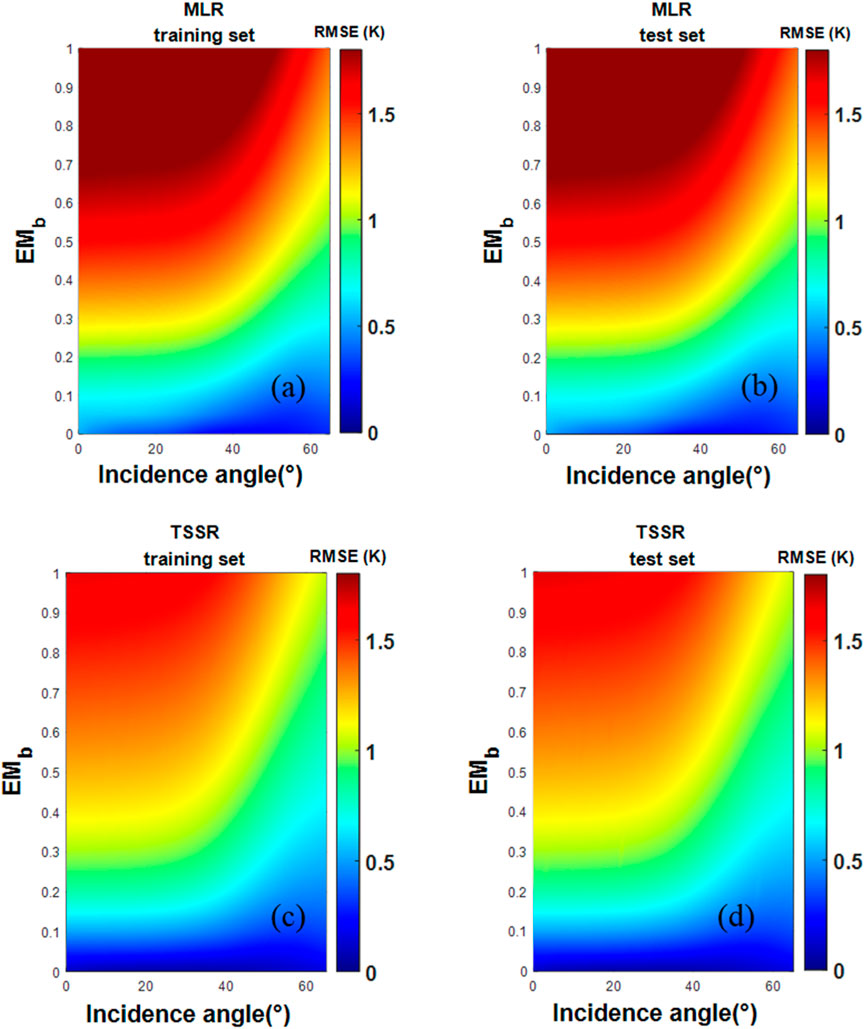
FIGURE 5. Relationship between SST retrieval errors, incidence angle, and
Figure 6 further illustrates the SST retrieval errors versus the incidence angle in the case of different
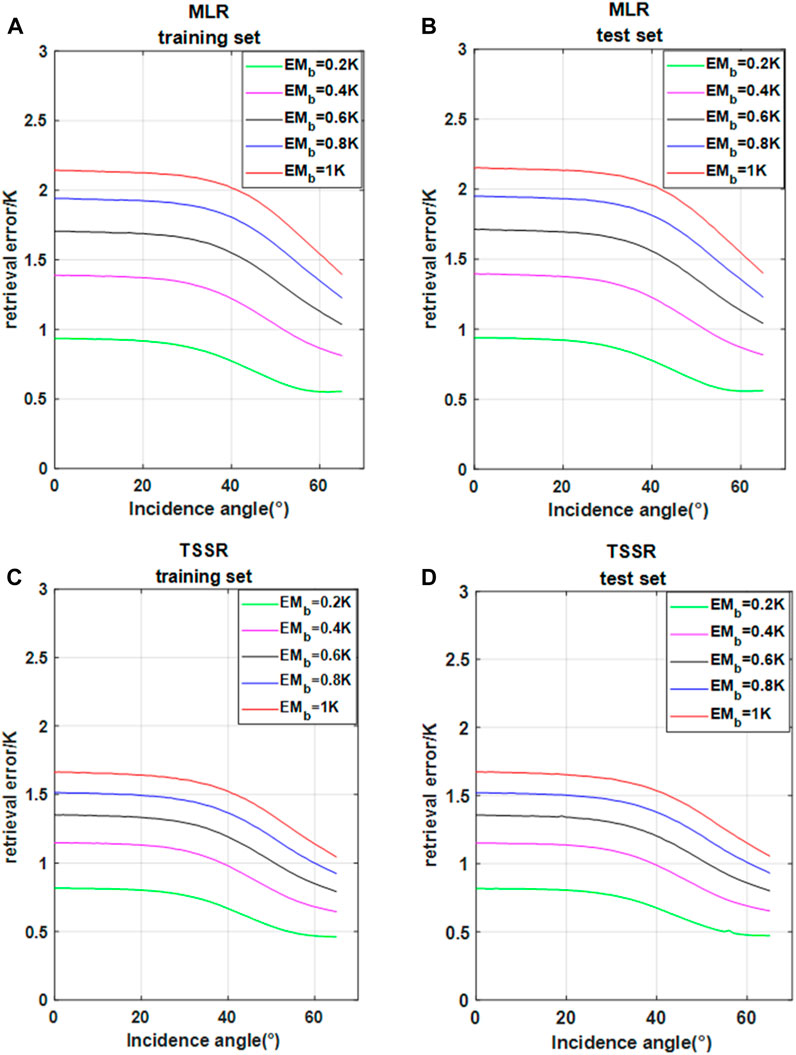
FIGURE 6. Relationship between SST retrieval error and incidence angle for different
C-band is the band that is most sensitive to SST. Sensitivity to the 6.9 GHz frequency (
where σ is the RMSE of retrieval error and
The relationship between
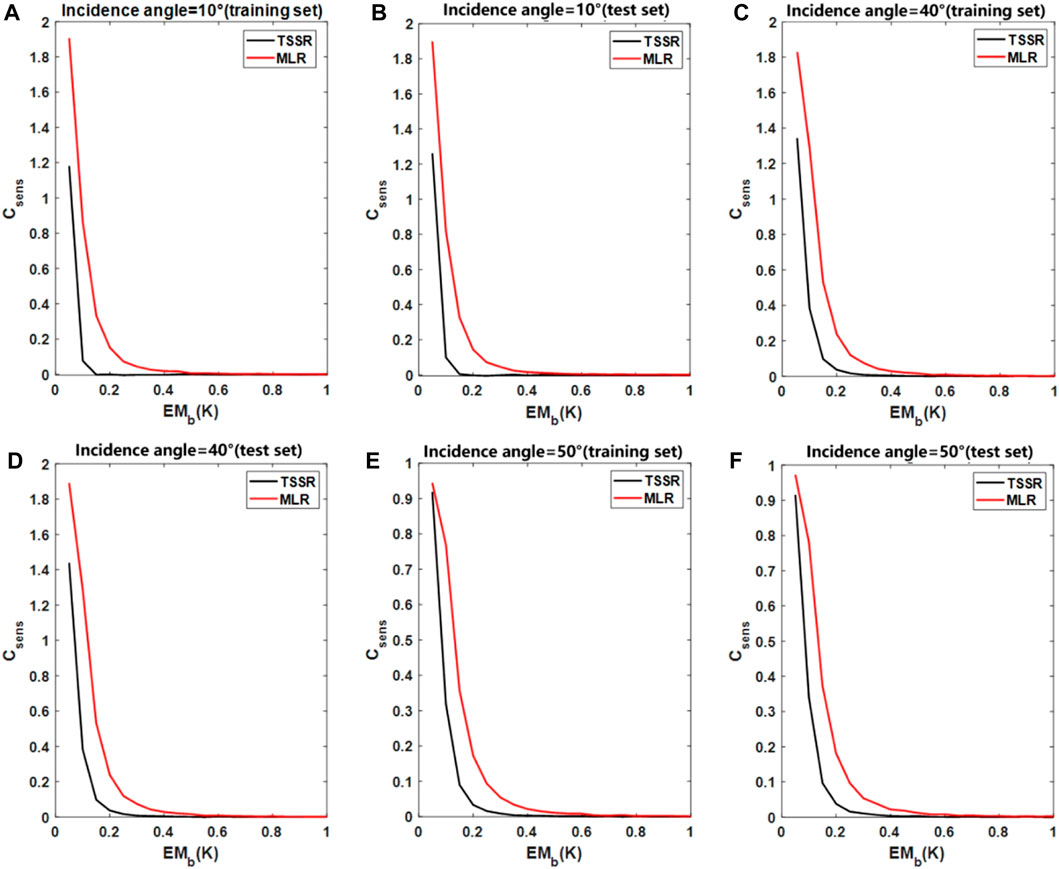
FIGURE 7. Relationship between
Among future on-board sensors for remote sensing of SST, 1D-MSAMR has excellent potential. This study used the MLR algorithm, which has fast computation speed and small computational memory requirements, to develop an on-board SST retrieval algorithm for 1D-MSAMR. Although the systematic error terms of each channel of 1D-MSAMR cannot be accurately obtained, the maximum error was set at the upper limit of 1 K according to the systematic error published by the on-orbit real-aperture microwave radiometer. Surprisingly, TSSR improved the retrieval accuracy by about 25% on the basis of only one more set of regression coefficients compared to MLR, and TSSR was less affected by the EMb of 6.9 GHz. Therefore, the requirement of 6.9 GHz channel design can be appropriately reduced when TSSR is adopted. One reason for the improved performance of TSSR versus MLR is that, with TSSR, the initial retrieval value of SST is divided into intervals and then each interval is retrieved separately. The SST has obvious zonal distribution characteristics (high SST at low latitude), and the sensitivity of each channel to SST is nonlinear (Feng et al., 2021). Therefore, it is more reasonable to adopt different coefficients for different SSTs. TSSR has the capacity for automatic operation without manual intervention. After running for a period of time, the algorithm can automatically update the coefficients of the two-step method and improve the retrieval accuracy by using the temperature data of the sea buoy. However, this study was based on simulation data. Although the Gaussian error we added to each channel was generated separately, the error of each channel has the same distribution (mean value is 0, variance is the same), which is not common in the actual 1D-MSAMR system. Although our simulation model is scientific, it still needs future verification and adjustment based on actual 1D-MSAMR measurement data.
Due to the different baselines of small antennas at different frequencies, it is difficult for the spatiotemporal synchronous observation areas to coincide completely, which leads to the problem of high spatial resolution at high frequencies and low spatial resolution at low frequencies. However, the premise of TSSR algorithm application is that the measured brightness temperature of each channel has spatiotemporal matching. Therefore, before applying TSSR, it is necessary to preprocess the measured brightness temperature so that the measured brightness temperature of each channel corresponds to the same detection area.
There is an advantage to using a microwave radiometer to monitor SST under conditions of weak precipitation. Precipitation will increase the roughness and change the emissivity of the sea surface. Due to limitations of the simulation model, the sea surface emissivity in the presence of precipitation cannot be calculated, so we did not study the retrieval of SST under those conditions; future studies will address measurement of SST via the 1D-MSAMR in the presence of precipitation. The 1D-MSAMR used in our study has five frequencies. The detected brightness temperature contains more information about the sea surface and atmospheric environment, and the five frequencies include those that are sensitive to water vapor content and weak precipitation (23.8 GHz and 36.5 GHz, respectively). Therefore, 1D-MSAMR retrieval of SST under conditions of weak precipitation is theoretically feasible, and a direction to be explored in our future research.
4 Conclusion
MLR requires minimal computation capacity, which makes it a good option for an on-board retrieval algorithm. In this study, an SST retrieval algorithm (TSSR) was proposed to evaluate the SST retrieval error for 1D-MSAMR based on MLR. We investigated the relationship between retrieval errors and brightness temperature measurement errors (
Data availability statement
The original contributions presented in the study are included in the article/Supplementary Material; further inquiries can be directed to the corresponding author.
Author contributions
Conceptualization, CG and WA; methodology, CG and WA; software, SH and MF; validation, JQ, WA, and SH; formal analysis, JQ and WA; investigation, JQ and WA; resources, SH; data curation, JQ and WA; writing—original draft preparation, JQ and WA; writing—review and editing, JQ and WA; visualization, JQ and WA; supervision, ML; project administration, JQ and WA.
Acknowledgments
We would like to express our gratitude to Professor Frank J. Wentz for his great help in our research. We are thankful for the support from the National Natural Science Foundation of China (41605016). We would like to express our gratitude to Edit Springs (https://www.editsprings.com/) for the expert linguistic services provided. We acknowledge WindSat in Remote Sensing Systems (RSS) for providing the data. The data, including the RSS WindSat Data Products, can be obtained online (http://www.remss.com/missions/windsat/).
Conflict of interest
The authors declare that the research was conducted in the absence of any commercial or financial relationships that could be construed as a potential conflict of interest.
Publisher’s note
All claims expressed in this article are solely those of the authors and do not necessarily represent those of their affiliated organizations, or those of the publisher, the editors, and the reviewers. Any product that may be evaluated in this article, or claim that may be made by its manufacturer, is not guaranteed or endorsed by the publisher.
References
Ai, W., Feng, M., Chen, G., and Lu, W. (2020). Research on sea surface temperature retrieval by the one-dimensional synthetic aperture microwave radiometer, 1D-SAMR. Acta Oceanol. Sin. 39 (5), 115–122. doi:10.1007/s13131-020-1540-1
Bobylev, L. P., Leonid, E., ZabolotskikhElizaveta, V., Mitnik, , and Leonid, M. (2010). Atmospheric water vapor and cloud liquid water retrieval over the arctic ocean using satellite passive microwave sensing. IEEE Trans. Geosci. Remote Sens. 48, 283–294. doi:10.1109/TGRS.2009.2028018
Bettenhausen, M. H., Smith, C.K., Bevilacqua, R. M., Wang, N. Y., Gaiser, P. W., and Cox, S.(2006). A nonlinear optimization algorithm for WindSat wind-vector retrievals. IEEE Trans. Geosci. Remote Sens. 44(3), 597–610. doi:10.1109/tgrs.2005.862504
Brown, J., Simmonds, I., and Noone, D.(2006). Modeling delta O-18 in tropical precipitation and the surface ocean for present-day climate. Journal of Geophysical Research-Atmospheres. 111(D5). doi:10.1029/2004jd005611
Chelton, D. B., and Wentz, F. J. (2005). Global microwave satellite observations of sea surface temperature for numerical weather prediction and climate research. Bull. Am. Meteorol. Soc. 86 (8), 1097–1116. doi:10.1175/BAMS-86-8-1097
Corbella, I., Duffo, N., Vall-llossera, M., Camps, A., and Torres, F. (2004). The visibility function in interferometric aperture synthesis radiometry. IEEE Trans. Geosci. Remote Sens. 42 (8), 1677–1682. doi:10.1109/TGRS.2004.830641
Feng, M., Ai, W., Chen, G., Lu, W., and Ma, S. (2022). A multiple linear regression algorithm for sea surface temperature retrieval by one-dimensional synthetic aperture microwave radiometry. J. Atmos. Ocean. Technol. 37 (9), 1753–1761. doi:10.1175/JTECH-D-20-0003.1
Feng, M., Ai, W., Lu, W., Shan, C., Ma, S., and Chen, G. (2021). Sea surface temperature retrieval based on simulated microwave polarimetric measurements of a one-dimensional synthetic aperture microwave radiometer. Acta Oceanol. Sin. 40 (3), 122–133. doi:10.1007/s13131-021-1712-7
Goodberlet, M. A., Swift, C. T., and Wilkerson, J. C. (1990). Ocean surface wind speed measurements of the Special Sensor Microwave/Imager (SSM/I). IEEE Trans. Geosci. Remote Sens. 28 (5), 823–828. doi:10.1109/36.58969
Jin, R., Li, Q., and Liu, H. (2019). A subspace algorithm to mitigate energy unknown RFI for synthetic aperture interferometric radiometer. IEEE Trans. Geosci. Remote Sens. 58 (99), 227–237. doi:10.1109/TGRS.2019.2936005
Jordi, F., Camps, A., Andres, B., Martin-Neira, M., Boutin, J., Reul, N., et al. (2010). Smos: The challenging sea surface salinity measurement from space. Proc. IEEE 98 (5), 649–665. doi:10.1109/JPROC.2009.2033096
Koner, P. K., and Harris, A.(2015). “ A deterministic inversion technique for sea surface temperature retrieval from MODIS radiances,” in Conference on Ocean Sensing and Monitoring VII. doi:10.1117/12.2179868
Krasnopolsky, V. M., Gemmill, W. H., and Breaker, L. C.(2000). A neural network multiparameter algorithm for SSM/I ocean retrievals: Comparisons and validations. Remote Sens. Environ. 73 (2), 133–142. doi:10.1016/s0034-4257(00)00088-2
Lambrigtsen, B., Brown, S., Gaier, T., Kangaslahti, P., Tanner, A., and Wilson, W. (2006). “GeoSTAR : Developing a new payload for GOES satellites,” in Aerospace Conference (IEEE).Big Sky, MT, March October 04–11, 2006
Le, V., and David, M. (1990). The sensitivity of synthetic aperture radiometers for remote sensing applications from space. Radio Sci. 25 (4), 441–453. doi:10.1029/rs025i004p00441
Le, V., Griffis, A., J., Swift, C., T., and Jackson, T. (1994). Estar: A synthetic aperture microwave radiometer for remote sensing applications. Proc. IEEE 82 (12), 1787–1801. doi:10.1109/5.338071
Li, Q., Ke, C., Wei, G., Liang, L., and Chen, L. (2008). “An aperture synthesis radiometer at millimeter wave band,” in International Conference on Microwave & Millimeter Wave Technology, Nanjing, 21-24 April 2008.
Lise, K., Catherine, P., Filipe, A., Boutin, J., Heygster, G., Tonboe, R. T., et al. (2018). Expected performances of the copernicus imaging microwave radiometer (CIMR) for an all-weather and high spatial resolution estimation of ocean and sea ice parameters. J. Geophys. Res. Oceans 123 (110), 7564–7580. doi:10.1029/2018JC014408
Meissner, T., and Wentz, F. J. (2012). The emissivity of the ocean surface between 6 and 90 GHz over a large range of wind speeds and earth incidence angles. IEEE Trans. Geosci. Remote Sens. 50 (8), 3004–3026. doi:10.1109/TGRS.2011.2179662
Obligis, E., Labroue, S., Amar, A., Thiria, S., Crepon, M., and Mejia, C.(2005). RETRIEVING THE OCEAN SALINITY FROM SMOS OBSERVATIONS BY THE USE OF NEURAL NETWORKS.
Prigent, C., Aires, F., Bernardo, F., Orlhac, J. C., Goutoule, J. M., Roquet, H., et al. (2013). Analysis of the potential and limitations of microwave radiometry for the retrieval of sea surface temperature: Definition of MICROWAT, a new mission concept. J. Geophys. Res. Oceans 118 (6), 3074–3086. doi:10.1002/jgrc.20222
Ruf, C. S., Swift, C. T., Tanner, A. B., and Le Vine, D. M. (1988). Interferometric synthetic aperture microwave radiometry for the remote sensing of the Earth. IEEE Trans. Geosci. Remote Sens. 26 (5), 597–611. doi:10.1109/36.7685
Schanda, E. (1979). “Multiple wavelength aperture synthesis for passive sensing of the Earth's surface,” in Antennas & Propagation Society International Symposium, Seattle, WA, USA, 18-22 June 1979, 597–611.
Ulaby, B., Moore, R. K., and Fung, A. K. (1981). Microwave remote sensing: Active and passive. Volume 1 - Microwave remote sensing fundamentals and radiometry.
Vine, D., Griffis, A., Swift, C. T., and Jackson, T. J. (1992). “Estar: A synthetic aperture microwave radiometer for measuring soil moisture,” in International Geoscience & Remote Sensing Symposium. Houston, TX, May 26–29, 1992
Vine, D., Haken, M., and Swift, C. T. (2004). “Development of the synthetic aperture radiometer ESTAR and the next generation,” in Geoscience and Remote Sensing Symposium, 2004. IGARSS '04. Proceedings (IEEE). Anchorage, AK, September 20–24, 2004
Vine, D. (2000). Synthetic aperture radiometer systems. IEEE Trans. Microw. Theory Tech. 47 (12), 2228–2236. doi:10.1109/22.808964
Wentz, F. J. (2000). Algorithm theoretical basis document (ATBD) AMSR ocean algorithm. EOS Project, Goddard Space Flight Center, National Aeronautics and Space Administration.
Wentz, F. J., and Meissner, T. (2007). Supplement 1: Algorithm theoretical basis document for AMSR-E ocean algorithms. Santa Rosa, CA: NASA.
Keywords: space-borne one-dimensional multifrequency synthetic aperture microwave radiometer, sea surface temperature retrieval, two-step retrieval algorithm, multiple incidence angles, frequency
Citation: Guo C, Ai W, Liu M, Feng M, Qiao J and Hu S (2022) Sea surface temperature retrieval based on simulated space-borne one-dimensional multifrequency synthetic aperture microwave radiometry. Front. Environ. Sci. 10:1054076. doi: 10.3389/fenvs.2022.1054076
Received: 26 September 2022; Accepted: 03 November 2022;
Published: 28 November 2022.
Edited by:
Dongmei Xu, Nanjing University of Information Science and Technology, ChinaReviewed by:
Yinan Li, China Academy of Space Technology (CAST), ChinaMukesh Gupta, Independent Researcher, Calgary, AB, Canada
Copyright © 2022 Guo, Ai, Liu, Feng, Qiao and Hu. This is an open-access article distributed under the terms of the Creative Commons Attribution License (CC BY). The use, distribution or reproduction in other forums is permitted, provided the original author(s) and the copyright owner(s) are credited and that the original publication in this journal is cited, in accordance with accepted academic practice. No use, distribution or reproduction is permitted which does not comply with these terms.
*Correspondence: Weihua Ai, YXdoempheEAxMjYuY29t
 Chaogang Guo
Chaogang Guo Weihua Ai*
Weihua Ai*